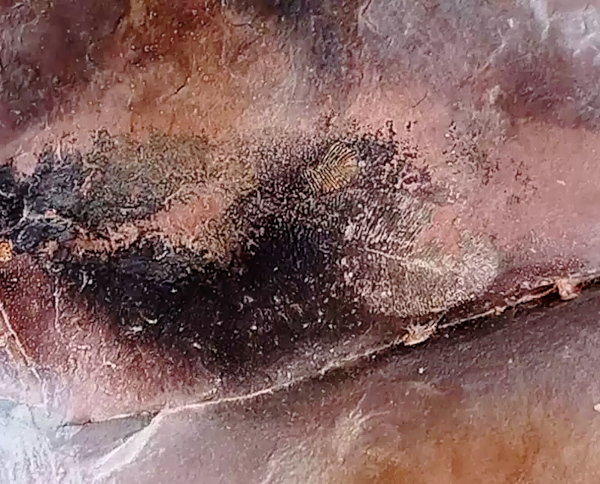BHOPAL: Hidden in plain sight, one of the rarest fossils in the world may have been discovered in the fascinating Bhimbetka rock shelters, a Unesco site about 40km from Bhopal.
Researchers believe they have found the first-ever fossil in India of a Dickinsonia —the Earth’s ‘oldest animal’, dating back 570 million years — on the roof of what’s called the ‘Auditorium Cave’ at Bhimbetka.
The find has been published in the February edition of Gondwana Research, an international journal. Dickinsonia fossils have shown they could exceed four feet in length but the one found in Bhimbetka is 17 inches long.
Like the awe-inspiring rock shelters themselves, this fossil was discovered by chance. Two experts from Geological Survey of India (GSI) were on a sightseeing tour of Bhimbetka ahead of the 36th International Geological Congress, which was scheduled for March 2020 but was postponed twice due to the pandemic, when they spotted the leaf-like impression.
Eleven feet above the ground, almost blending with the rock and easily mistaken by laymen for prehistoric rock art, they found imprints of the Dickinsonia, believed to be one of the key links between the early, simple organisms and the explosion of life in the Cambrian Period, about 541 million years ago.
“The fossils were found in the roof of Auditorium Cave at Bhimbetka Rock Shelters, a Unesco World Heritage Site for Paleolithic and Mesolithic cave art, near Bhopal. They are identical with Dickinsonia tenuis from the Ediacara member of the Rawnsley Quartzite in South Australia,” says an abstract of the paper ‘Dickinsonia Discovered in India and Late Ediacaran Biogeography’ in Gondwana Research, posted on the web.
The writeup is attributed to Gregory J Retallack, Neffra A Matthews, Sharad Master, Ranjit G Khangar and Merajuddin Khan. “The discovery of Dickinsonia in India allows assessment of biogeographic provinces and plate tectonic reconstructions for the late Ediacaran,” it says, adding: “This new occurrence confirms assembly of Gondwanaland by 550 Ma, but not reconstructions adjusted for true polar wander. Cloudina and other small shelly marine fossils were low latitude, but vendobionts such as Dickinsonia were at temperate to subtropical latitudes.”
How did it lie undiscovered all these years? The Bhimbetka rock shelters were found by V S Wakankar 64 years ago. Since then, thousands of researchers have visited the site, but this rare fossil went undetected.
“ASI deals in geologic time scale, quaternary period, that began 2.6 million years ago and extends into the present. Anything before the beginnings of human evolution is not covered,” said retired ASI joint director general, S B Ota. “I have seen the picture on social media. It is on a deposit on sedimentary rock. A paleobotanist could determine its genesis,” he added.
A GSI team had conducted extensive work in the Vindhyan Hills some 20 years ago to meet operational guidelines of Unesco before Bhimbetka was declared a world heritage site. GSI mapped the area and since then the number of rock shelters has increased from 400 to 1000, said Ota, who is also a Tagore research fellow.
Vindhyan Hills, where these rock paintings are located is an area of massively sculpted sandstone rock formations clustered around cave-art rich Bhimbetka Hill. “Again, GSI scope was limited to quaternary,” he said.
Suddenly, time lapse has a whole new meaning at Bhimbetka. The ancient cave art is young, compared to Dickinsonia. According to Unesco, the Bhimbetka rock art is believed to date from the Mesolithic period (around 10,000 years ago), through the Chalcolithic (Microlithic) and right into the historic, medieval and recent historic periods. “Cosmogenic nuclide dating is being deployed to determine time of earliest human culture. India’s oldest stone-age tools, up to 1.5 million years old, are at a prehistoric site near Chennai,” said Ota.
Does ASI have any plans for it? “We have received no request for sampling of Dickinsonia,” said ASI Bhopal superintendent, Piyush Bhatt.
Source: ToI
You may also like
-
New Heat-Based Approach To Cancer Treatment Can Reduce Chemotherapy Doses
-
Scientists Take A Major Step Towards Unification Of Classical & Quantum Gravity
-
India Graphene Engineering and Innovation Centre (IGEIC) Under the Vision of Viksit Bharat@2047 Launched
-
New High-Performance Gas Sensor can Monitor Low Level Nitrogen Oxides Pollution
-
Antidepressant Drug can be Repurposed for Treating Breast Cancer
